- Home
- Injections
- Laser Treatments
- Specialties
Specialtiesview all
- Other Treatments
- Before After Photos
Before After Photosview all
- Contact Us
- Doctor And Staff
- About Celibre
- Blogs
Over the past several years, it has become more commonplace to treat patients for non-surgical nose shaping. In many cases, the patient does not necessarily have an issue that is well suited to surgery, or the patient does not prefer surgery for one reason or another.
We use Radiesse in situations where a patient prefers non-surgical nose shaping. An example of the work is below for “Asian Nose Shaping”. This patient was trying to achieve a straighter line between the forehead and mid nose (at the bridge). We added Radiesse to the area so that she did not have such a concave shape at the bridge.
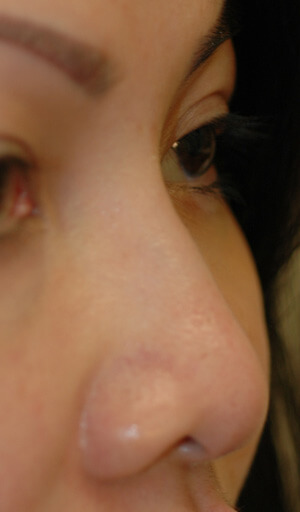

Think you need eyelid surgery to look better or younger? You may want to think again. Non-surgical treatments for rejuvenating your eyes can have a big impact on your appearance and in some cases, are a better answer for erasing those pesky crow’s feet.
If you are under the age of 60, and tired of seeing those horizontal lines at the outer corners of your eyes—also known as the crow’s feet—here are the top four treatments that can help you smooth out those wrinkles and take years off of your appearance.
Botox & Dysport for Crow’s Feet
Dysport and Botox were tailor-made for the crow’s feet. Because your crow’s feet develop from the repeated contraction of the circular muscle around your eyes Botox and Dysport can relax the muscles and erase the lines. What you’ll end up seeing after treatment is your same, beautiful smile, but no wrinkling and/or puckering skin at the corner of your eye. And that is something to really smile about!
No Downtime Laser Resurfacing for Crow’s Feet
Let’s say you’ve had Botox or Dysport treatment and that’s helped, but you still see etched-in lines? Or what if you just don’t want neurotoxins at all? If you’re busy and want to do something different or more, but don’t have any downtime to spare, consider non-ablative, no downtime laser resurfacing.
Here at Celibre Medical, we use both the Quantel Aramis and Palomar q-switched laser to firm and tighten this area and smooth away crow’s feet. These devices produce heat in the skin beneath the surface without damaging its outer layer. This stimulates new collagen and helps improve their appearance.
With the benefit of no downtime, however, come a few drawbacks. Your results will be more gradual and more limited than Botox or a full laser resurfacing. You will likely need several treatments, but, if downtime is an issue for you, these treatments are a good option!
Fractional Laser Resurfacing for Crow’s Feet
If you can spare a few days to heal, then fractional laser resurfacing may be the treatment for you. Our go-to device for this type of laser resurfacing is the Sciton Profractional. It works by creating thousands of microscopic perforations in your skin. Each of these is its own separate “micro” wound that your body must create new collagen to fill. The end result is almost entirely new skin and collagen around the eyes which helps your skin look smoother and tighter while reducing the appearance of your crow’s feet.
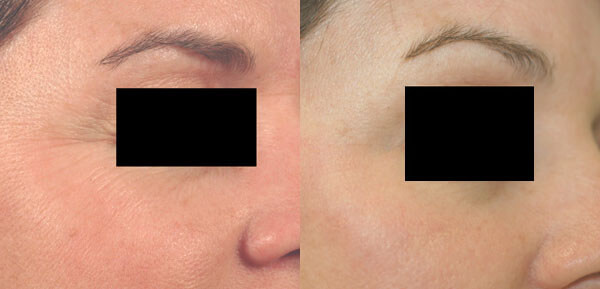
Laser Resurfacing for Crow’s feet
This treatment is more aggressive than the one discussed previously, but also has more dramatic results. The trade-off is that you need to take 5 to 7 days (in general) to allow your skin to heal before you return to work and or other activities.
Skin Care Products
Keep in mind as you’re reading this that these treatments can all be used in combination with one another. This last option is no different. Instead of thinking that one is “better” than another, consider them all to be complimentary. Proper skincare products can help your crow’s feet too, but will often be most beneficial when used with one or more of the treatments that we’ve already discussed. For skincare around the eyes, Retin-A products and glycolic acid-containing products can both be the “icing on the cake” to any of the previous treatments and they work by refreshing the skin because of their exfoliating properties.
Celibre Medical has numerous options that can fit any skin type (sensitive, etc.) and budget. If you’re serious about making an investment in the appearance of your eyes, talk to us about injections, laser treatments, or skincare products!
If you’ve been thinking about dermal filler injections, you may have asked yourself the question, ”What happens if something goes wrong?”, or “What if I don’t like the way I look?” We understand the concern. Making the decision to change your appearance, also requires you to consider the potential risks as well. From our experience, looking natural is the most important factor for our patients when considering dermal filler injections.
At Celibre Medical we thoroughly discuss your concerns, evaluate your individual features, and then educate you fully on all your treatment options. Not every practice does this. Too often, we see patients from another practice that were not fully informed of the risks or just had subpar results because they did not fully understand what treatments were being performed. Thankfully, many of these cases involve the use of hyaluronic acid-based fillers such as Juvederm, Restylane, Voluma, Belotero, RHA, Versa, etc. To help patients that have had bad filler injections, we use an enzyme to reverse the effects and remove the fillers. It’s called hyaluronidase and it breaks the bonds that tie together synthetic hyaluronic acid-based products together. Results are mostly immediate but full effects are seen within 24 hours of injection. We use the hyaluronidase brands Hylenex and Vitrase.
Hyaluronidase enzymes work by breaking down the chemical bond between the molecules of hyaluronic acid (HA) in products such as Restylane and Juvederm. Breaking the chemical bond that ties the molecules of synthetic hyaluronic acid together dissolves the gel and reverses the effects of the filler procedure. It starts to work very quickly — usually within seconds and can sometimes completely remove your hyaluronic acid-based filler in less than a day. In other cases, more than one visit is required. It’s important to point out that Hyaluronidase only works on synthetic HA-based fillers. There is no similar reversal method for different types of dermal fillers and biostimulators such as Radiesse, Sculptra and/or Bellafill.
To give you a better idea of what Hylenex or Vitrase can do, take a look at the before and after photos of a patients we treated (above). The cases show before and after photos of dermal filler reversal for the under eyes, lips and cheeks. The reality is that hyaluronidase can be used anywhere in the body that synthetic hyaluronic acid-based dermal fillers have been injected. One of the most common places for reversal is under the eyes. The “tear troughs”, as the area of dark circles under the eyes is called, is one of the most difficult areas of the face to inject well. It is very product and technique dependent to get a good outcome, so often when we get a call to reverse a dermal filler, it is about bad injections for dark circles under the eyes. In this area, we see too much filler placed, filler that was placed too close to the skin’s surface and, finally, fillers that should not be used in this area and appear lumpy or bumpy. These patients often suffer for days, weeks, months or even years before finding a solution to a bumpy, puffy or swollen appearance. Within minutes of their hyaluronidase injections, they look better and have some relief.
It’s very common, especially on websites like Realself, for consumers to report and believe that the hyaluronidase enzyme in Hylenex and Vitrase breaks down the natural hyaluronic acid in the skin. Although this can occur in a very limited capacity, the effects are temporary. Your body produces and replaces hyaluronic acid in the skin every day, so if a deficiency from the norm is present after injection of hyaluronidase, the body will be correct it shortly thereafter. The primary role of the hyaluronidase is to effect the excess synthetic hyaluronic acid based dermal filler and this is easily accomplished by injecting into the bumpy areas where the synthetic filler can be seen or felt.
Hylenex and Vitrase are so effective at dissolving hyaluronic acid-based fillers that the effects will usually be seen in real time. In most cases, as soon as the solution is injected into the skin, the bumps dissolve and flatten. The caveat is that thicker dermal fillers require more solution, time and visits.
The answer to this question depends primarily on the type of filler that was injected initially. Hyaluronic acid based dermal filler brands such as Voluma, Lyft and Silk all have different designs and structures. Some fillers have a very smooth consistency while others are very thick and viscous. The number of treatments required to dissolve the products depends on how much filler was placed and the cross-linking properties of the filler. For very thick products like Vycross technology (Voluma), it can take 2, 3 4 or more visits to break down the product because the cross links (bonds) contained within the filler are numerous. The increased amount of cross linking makes a thicker dermal filler last longer, but also makes it more difficult to break down with hyaluronidase. In addition, some thicker fillers can cause “granulomas”, a type of response where the immune system walls off the filler, creating a capsule or pocket that separates it from the rest of the surrounding tissue. For thicker hyaluronic acid-based dermal fillers, more than one treatment will almost always be required. In addition, if a capsule or granuloma forms, this will also increase the number of treatments required to dissolve any bumps or lumps. The more difficult nature of dissolving Vycross technology (Allergan Voluma, etc) is one of the reasons we do not use it. The additional risk and difficulty associated with dissolving a product like Voluma do not make up for the marginal increase in duration over another dermal filler like Restylane Lyft.
If you’ve had a bad dermal filler injection in the under eyes, cheeks, lips or jawline, call us today to discuss dissolving the filler and starting over to create a more natural appearance.
We totally get it. You want to look and feel your best and you can’t break the bank at the same time. At Celibre Medical, we know and understand the importance of cost. We understand that your hard-earned dollars are important and that’s why we offer the highest level of care, expertise, and technology at a fair price.
Often, we get calls from prospective patients that ask only one question – How much do you charge for Botox (Dysport)? While we definitely agree that cost is an important factor, we also want to educate you on why the cheapest Botox might not be where you want to start your treatments.
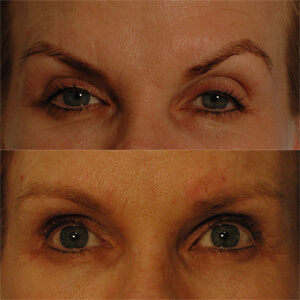 We’ve included photos of a patient who came to us after years of getting very cheap Botox somewhere else. As you can see from her photos, she had a bit of a peculiar arch to her brows that gave her a bit of a “Spock brow” appearance. She was not happy even though her pocketbook was! Despite knowing that it would cost more, she came to us for help.
We’ve included photos of a patient who came to us after years of getting very cheap Botox somewhere else. As you can see from her photos, she had a bit of a peculiar arch to her brows that gave her a bit of a “Spock brow” appearance. She was not happy even though her pocketbook was! Despite knowing that it would cost more, she came to us for help.
Together, we discussed what she disliked and what the corrective steps would be to fix her problem. By changing how she was injected, we created a whole different look for her that was much more natural and appealing. Her forehead is smooth and her brows have a much more subtle arch. She is happy and we’re happy that she’s happy!
Remember, cheap Botox is not always good Botox. When you consider only price, you can easily overlook many factors that go into that number. The time, training, and experience of your provider are figured into that price too! And these have value. In fact, they can be the difference between walking away from a happy and satisfied patient or walking away wishing you’d gone somewhere else!
If you’re always searching for a Groupon for your next Botox treatment, ask yourself why these practices have to run specials on their Botox? Is it because patients don’t come back for repeat care? Or is it because they really can’t get anyone through their doors any other way? Whichever the reason, these practices simply might be missing the most important piece of the puzzle: a great injector!
You’re browsing Realself and you keep coming across the term “brow shaping”. If you’re thinking this term relates to plucking, tweezing, or waxing the eyebrows, think again! In the aesthetic world, brow shaping refers to techniques and treatments that change the position, lift/arch, and or volume of the eyebrow and the area around it.
Why is this important? Because no other area reveals more information about your age than your eyes. Signs of sun damage, volume loss, and skin laxity show up here first before anywhere else on your face. A skilled aesthetic practitioner knows this and understands the value of using minimally invasive treatments such as Botox Cosmetic and dermal filler injections to correct and reverse these changes.
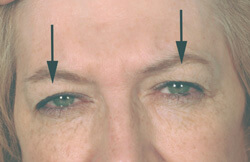
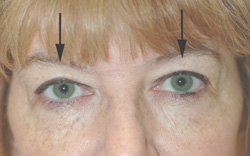 If you feel like your brows are flat, there’s an easy way to both lift and arch them with Botox. When precisely and carefully placed into the right facial muscles, Botox can completely change the shape and position of your eyebrows. Lifting them, opening up your eyes, and smoothing out the skin around the eyes can take years off your appearance.
If you feel like your brows are flat, there’s an easy way to both lift and arch them with Botox. When precisely and carefully placed into the right facial muscles, Botox can completely change the shape and position of your eyebrows. Lifting them, opening up your eyes, and smoothing out the skin around the eyes can take years off your appearance.
If your brow bone (or bony eye socket) has flattened, then injections with dermal filler products such as Juvederm and Restylane can softly and naturally reshape your brow. This in turn also lifts and shapes the eyebrow. Are your eyes looking hollow? Temples sunken in? Do these changes make your eyes look sharp or angular? If so, hyaluronic fillers such as Restylane can safely be used under your eyes and in your temples to add volume, and “round out” your upper face.
Restoring the balance and natural contour of your eyes can help you look refreshed, younger and relaxed. Remember, your eyes are the focal point of your face—your most important facial feature!
Read About All Celibre’s Facial Shaping Techniques
This is not only a common question but a common misconception. Botox works by relaxing the muscle by inhibiting the neurotransmitter needed for muscle contraction. This effect is very specific and temporary. The goal of Botox injections is to relax the particular facial muscles that cause fine lines, wrinkles, and creases.
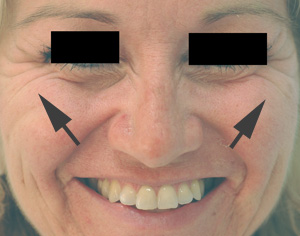

At Celibre, our team believes in achieving a natural look wherein some muscle function is maintained for animation and expression while minimizing the strong contractions of the muscles that lead to unwanted outcomes.
Always express your concerns and questions to the Botox practitioner so that they may provide you with the appropriate feedback and education. If they are not willing to involve you in this process, look for another facility that does.
Millions of people in the United States receive Botox injections on a regular basis not only because of its proven safety record but also because of the desired, predictable outcomes.
Look at the photo on this page for a moment. Notice anything that looks a bit off? There it is! Now you see it: the dreaded joker eyebrows! This unappealing, telltale sign of bad Botox is easy to spot when only the outer half of someone’s eyebrows move as they are talking to you! It looks unnatural and almost comical, so surely this would be a rare occurrence, right? Wrong!
Contrary to what most people believe about Botox, it is a procedure that requires both technical skill and in-depth knowledge of facial muscle anatomy. Injectors who lack one or both can make you look like this poor gentleman in the photo because they simply don’t understand how to properly administer Botox.
Only licensed, medical professionals—Registered Nurses, Physician Assistants, Nurse Practitioners, and Physicians—are permitted to administer Botox injections. In California, our state regulations go one step further. If you are injected by anyone other than a physician, he or she must be at a practice that is under his/her or have a standardized procedure in place. This helps to ensure that a physician dictates the standard of care at that practice and that all medical personnel follows these standards when providing treatments for patients.
This explains who is legally allowed to provide Botox injections, but it still doesn’t answer the question of who is qualified to do them. This is a very important distinction for you to make because these really are two, very different things. We would even go as far as to say that legal qualification does not equate to good Botox injection technique and safety.
You might assume that you’d have better Botox results if you were injected by a physician rather than a nurse. We’d encourage you to challenge this line of thinking! It honestly doesn’t matter what the credentials behind an injector’s name are—it only matters how much knowledge and experience they have in performing your procedure.
So, when you’re deciding who you’d like to have performed your injections, make sure that you ask questions! Get a feel for their experience and qualifications. Look through some before and after photos. This type of information can tell you volumes about the kind of results you achieve – more so than the number of years that your injector went to school! Always remember that you are your own best advocate.
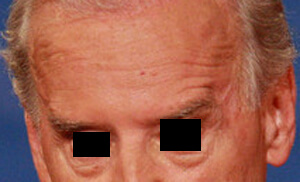
Now, back to our gentleman in the photo…THIS IS NOT A CELIBRE MEDICAL BOTOX PATIENT. However, he did come to us asking for help as he was unhappy with the results he received at another facility.
Let’s talk for a bit about just what went wrong with this fellow. “Joker eyebrows” happen when only the central/middle part of the forehead muscle (the frontalis) is relaxed with Botox. It is the muscle that is responsible for pulling the eyebrows up towards the hairline. The frontalis muscle is not shaped the same on every face, nor does it have the same pattern of contraction in every person. His injector clearly did not recognize (or take the time to examine) his unique frontalis anatomy and contraction pattern. As a result, he was “under-treated” or not treated at all in the outer part of his frontalis (forehead) muscle. And to make matters worse, the middle part is so affected by Botox (i.e. relaxed), that it forces the outer/untreated part of his muscle to work even harder—making him look even more abnormal!
A qualified Botox injector is one that knows the correct dose of Botox to give, but also exactly where and how to inject it. If any of these variables are incorrect, an abnormal, unnatural, and unhappy-looking patient is the end result.
All of these skills are more dependent on the training and experience of the practitioner holding the syringe than they are of the letters behind their name. While a title does mean something, it doesn’t always mean instant qualification. Nowhere else in medicine is this truer than in cosmetic dermatology procedures. Take the time to vet your injector and learn about their background, training and history. It will save you time and money in addition to your sanity!
Everyone sweats. It is a very natural and important way that our body regulates its temperature when we are warm or physically active. But for some, the sweating continues even at rest. And not just in the underarms. Hyperhidrosis can affect the palms of the hands and the soles of the feet. If you’re experiencing this frustrating condition, there are excellent options available to control it.
Hyperhidrosis may not sound all that bad, but if it affects you, you know it can keep you from social activities, and intimate relationships and even interfere with professional occupations. We don’t know why Hyperhidrosis happens, but we know that in those with the condition, sweat glands are extremely active.
There were few options for hyperhidrosis prior to 2004. Common treatments included oral medications to slow down or blunt the part of the peripheral nervous system that stimulate the sweat glands, topical wipes, and solutions that contained aluminum chloride to build plug the sweat duct. But, in 2004, the FDA approved Botox for hyperhidrosis treatment.
Most people think of Botox as only a cosmetic treatment, but it’s used in medicine for several different conditions that involve muscle spasms and overactive muscle activity. It’s useful in treating Hyperhidrosis in a similar way in that it blocks the receptors for acetylcholine which is the major chemical messenger that stimulates sweat secretion.
Treatment involves a grid-like pattern of injections with small amounts of Botox into the areas of the underarms that sweat the most. The needle that is used is extremely small and there is very little discomfort during a treatment session. Most patients require about 50 units of Botox in each underarm, and the entire treatment session usually takes less than 20 minutes.
While this sounds like a lot of Botox, which can be expensive, we always inform our patients that the average duration of the effects of a single treatment session is usually four to eight months (six on average)! And there are no at-home creams, pills, or other tasks to keep up with. Botox treatments are an extremely safe, easy, and cost-effective way to eliminate excessive underarm sweating.
While there is no cure for excessive underarm sweating, Botox offers consistent, long-lasting results, and is much more.
Effective than the alternatives mentioned above – and with fewer side effects. While it may be a financial investment for patients with Hyperhidrosis, in our experience. patients like you consider Botox to be worth every penny.
Botox injections are not associated with any downtime. In fact, many people return to work or their regular routine immediately following Botox injections. As with any cosmetic injection, there is always a risk of bruising – some areas more so than others. Even with meticulous technique, bruising is sometimes unavoidable during Botox injections. For this reason, it is prudent to have treatments done one to two weeks before a special event. Speak with your practitioner about simple measures to help minimize the risk of bruising prior to your scheduled treatment. Overall, Botox injections are uneventful, but the outcomes are quite impressive!
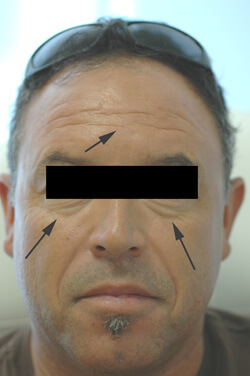
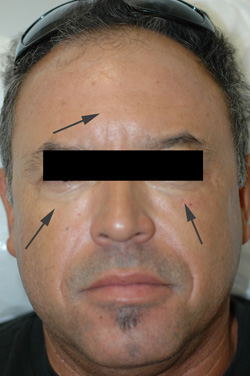
You’ve heard about Botox from your sister, best friend, neighbor, and hairstylist. It seems like everyone (except you) has had it! But what exactly does it do anyway? Even when you ask someone who’s had it, they really can’t answer. Don’t worry, we’ll tell you everything you need to know about what Botox is and how it works.
Botox a Neurotoxin
Botox is an actual botulinum toxin which is a neurotoxin that prevents muscle contraction. However, it’s not the same botulinum toxin that is found in nature. It is carefully controlled, precisely measured, and highly purified through the manufacturing process. This makes it extremely safe and easy to use. We know that the quantity of Botox delivered to the muscle will produce the intended effect without any type of whole-body (systemic) effect.
Injections of Botox are helpful anywhere where repeated muscle contractions cause lines and creases to form on your skin. The most common place occurs between your eyebrows (your frown lines), around your eyes (your crow’s feet), and on your forehead.
Does Botox paralyze my muscles?
Yes, this is partly true. Once injected into your muscle, Botox binds to a special receptor on it. This disrupts the normal, chemical “flow” of information from your nervous system to your muscle. Because of this, the muscle can’t respond to the brain’s signal to contract and the muscle stays relaxed. However, this process is temporary. As the muscle regenerates, it makes new receptors that are open. You will start to see your treated muscle(s) contract once again gradually as this occurs. Usually, after about 3 to 4 months the muscle is back to normal again and contracts just as it did before your Botox.
How was Botox first discovered?
Botox has been used in traditional medicine for a long time! Much longer than for cosmetic purposes. Doctors who treated patients with debilitating muscle spasms around the eyes (blepharospasm) first noticed that their patients’ foreheads were extremely smooth. They realized it was the Botox that was “diffusing” a bit from around the eye area that was making this pleasing side effect happen. Botox Cosmetic was born and has taken off since!
Botox is still used today to treat all sorts of medical conditions in addition to its cosmetic uses. Painful muscle spasms of the neck, bladder spasms, migraines, and excessive underarm sweating are just a few of the “medical” uses for Botox.
Will Botox tighten my skin?
No. This is a common “myth” about Botox. Most patients find that the “smooth” or “relaxed” look that they get from having Botox looks “tight”. If someone looks overly tight or “pulled”, then they have likely had a combination of a surgical facelift and/or brow lift in conjunction with their Botox treatment. This is extremely common, and we find this is the source of the “tight skin” myth surrounding Botox treatment.
Is Botox dangerous?
When purchased from Allergan, the company that produces Botox, we know that the minuscule amounts that we inject for cosmetic purposes are extremely safe. There have never been any deaths associated with the use of Botox Cosmetic—making it a safer drug than aspirin!
How long will my Botox last?
As discussed above, the effects of Botox are totally temporary. You will see your muscles start to contract again completely after about 3 to 4 months following your injections. With this in mind, it might be a good idea to go ahead and schedule your follow-up for your next treatment early, so that you continue to see the benefits of your Botox that we are sure you’re going to love!

So, you’ve made the decision to have your first cosmetic injection treatment and you’re told that you need a Good Faith Exam. What is it and why do you need it? If your injector is an RN, a Good Faith Exam is performed by an advanced medical practitioner (like an NP, PA, or MD) to ensure that you are healthy and a good candidate for these types of treatments.

 While you may think of Botox and dermal fillers like Restylane and Juvederm as fun, cosmetic (rather than medical) treatments that are given in a spa-like setting, it’s important to keep in mind that these injections are FDA-approved drugs/devices. In the state of California, they are treated like any other prescription drug, which requires an “order” from a licensed Physician, Physician Assistant, or Nurse Practitioner before you receive them. This means that you need an evaluation that includes a medical history and an exam prior to getting your treatment.
While you may think of Botox and dermal fillers like Restylane and Juvederm as fun, cosmetic (rather than medical) treatments that are given in a spa-like setting, it’s important to keep in mind that these injections are FDA-approved drugs/devices. In the state of California, they are treated like any other prescription drug, which requires an “order” from a licensed Physician, Physician Assistant, or Nurse Practitioner before you receive them. This means that you need an evaluation that includes a medical history and an exam prior to getting your treatment.
If you’re wondering if you’ll have to have a Good Faith Exam prior to each injection treatment, you don’t. Once you’ve had it for a certain procedure, you can continue to receive that treatment from your RN injector going forward. Your exam only needs to happen once, prior to your first injection.
We know that this sounds like it can be inconvenient, and we understand that you may even see it as a waste of time. Honestly, we admit that it is really a formality, in most cases. But here’s why a Good Faith Exam matters:
Remember, each state has its own laws about the “standards of care” regarding injectable procedures like Botox and dermal fillers. In California, you only need a Good Faith Exam by an NP, PA, or MD once before your first treatment with an RN. After that, you can continue to see just the RN for your injections.
We hope this page has helped you better understand the importance and significance of these exams. At Celibre Medical, we strive to be the leader in our industry when it comes to results and patient experience, but also when it comes to patient safety and protection. We will continue to adhere to and respect the laws that govern our practice because of that.
New patients that have Botox (or Dysport) injected for the first time want to know how long it will take for the product to take effect. This is a natural question and given that a reunion, wedding, or family party is often the reason why a patient would try Botox the first time.
You can expect your Botox to take full effect between several days after treatment and about 2 weeks after treatment. The average for our patients is about 3-7 days. By “full effect” we mean the time when you will see maximum relaxation of the muscle groups that have been injected and maximum smoothing of the lines and wrinkles.

One of the reasons we began using Dysport as an alternative to Botox is because patients experience a full onset of Dysport usually after 1-2 days. So, if you have a party or wedding coming up in the next couple of days, Dysport may be the way to go.
Botox (and Dysport) are both Botulinum Toxin Type A. The drug is a neurotoxin that interrupts the contractile capabilities of the muscle it is injected into. This means you can no longer “flex” the muscles after injection. The drug accomplishes this relaxation of the muscle in approximately 2-7 days after it is injected, so you will slowly lose the ability to frown over several days.
After Botox (Dysport) takes effect, the most common side effect is a condition called ptosis. This is a temporary sagginess or heaviness in the brow and or eyelid. It happens when the drug migrates to an adjacent muscle group. Although the side effect can be troubling, it is always temporary and usually resolves within 4 weeks.
Since 2004, we have treated thousands of patients using Botox (and Dysport). In the many thousands of patients, we have only found a few that are either resistant or allergic to Botulinum Toxin Type A. We have never had a patient respond negatively to the drug the first time they use it, but if repeated treatments are performed too close together, the body does have the ability to build up a resistance that can either look like an allergy or result in the product not working well.
Botox and Dysport typically last about 3-4 months for those that do not use the drugs consistently. If you are a consistent user of Botox or Dysport (every 4 months for the first year), then it’s not unusual to see the duration between treatments extend to 4 -5 months. While this certainly varies from patient to patient, those patients that use the drug consistently get the longest duration between treatments.
The drug Botox has been used medicinally for several decades. Despite this, many people don’t fully understand what it is or how it works. Worse, there is a lot of misinformation out there on Botox, and consumers often believe that Botox Cosmetic is dangerous or toxic. We want to set the record straight so that you have the facts on what exactly Botox is and how it’s used.
What is Botox?

Botulinum toxin (Botox) is a drug and a neurotoxin. It is a protein that is produced naturally by the bacterium Clostridium botulinum. The commercially available form of Botox is made under strict conditions in a laboratory setting. The protein is carefully measured, freeze-dried, and sterilized in a glass container or vial. Once it gets to your injector’s office, it can be stored in the refrigerator until it is ready to be used.
The protein powder mixed with saline looks like clear water before it’s injected. Once it’s mixed, your injector can measure the exact number of units of Botox based on the volume of liquid in a syringe. This is how you “dose” Botox.
Is Botox a Poison?
No. Commercially prepared Botox is not poisonous however, it is a toxin. Just like any other drug, such as alcohol, it will produce an effect on your body. And just like any other drug, if it is misused or overused, it may cause unwanted or harmful effects. It is important for you to understand that botulism and Botox are not the same things. To prove that point, we let our patients know that Botox has a better safety record than over-the-counter aspirin!
There have been a few lawsuits in the past claiming that cases of death were due to Botox. If you look at these, you’ll find that Botox has never definitively been linked to a death. Another important point is that these cases involved very high doses of Botox commonly used for other medical conditions like cerebral palsy—not the small doses that we use to treat cosmetic conditions.
Is Botox Safe?
Yes. Although you may think of Botox as a “fun” treatment that’s given in a spa or a more relaxed setting, you need to remember that it is still a drug. Like other drugs such as Tylenol, aspirin, and alcohol, Botox can be toxic or harmful when used incorrectly or improperly. When it’s used how it’s supposed to be, Botox is extremely safe and gives predictable, enjoyable results!
Remember that only tiny doses of Botox are used to smooth away unwanted lines and wrinkles. When Botox is used for other conditions such as the painful muscle spasms of cerebral palsy, the doses can be 20, 50, or even 100 times higher! Yet, these are still safe doses of Botox that provide relief for these patients without causing any harm.
How Do I Know How Much Botox I am Getting?
Ultimately, unless you’re mixing and drawing up your own Botox before your treatment, you don’t! The most important safeguard is finding a good injector that you can build a trusting relationship with.
As a rule, if the effects of your Botox last about 3 to 4 months, then you are getting the correct dosage. If you notice that it doesn’t last that long, you may not be getting what you need and you should discuss this with your injector.
This is an extremely common question for almost every patient who comes to us interested in learning more about Botox. Unfortunately, the answer is not as straightforward as you might think! Treating “the forehead” with Botox (in reality) means that your injector must evaluate and potentially treat three different areas of your upper face. Why? Because simply injecting Botox into a single muscle of the forehead can lead to you looking worse than better!

Most people know that the goal of having Botox is to smooth away lines and wrinkles, look more refreshed and relaxed, and overall, look younger! However, getting good results rests a lot more on where you are injected with Botox rather than simply how many units you’re injected with. Let us explain a little bit more about the anatomy of your upper face to help you understand how we get great results with Botox.
The Glabella
This funny-sounding name is the anatomical term for a set of three muscles that lie between and just above the inner part of your eyebrows. Why do we talk about this area first when trying to understand more about Botox for the forehead? Because most people who want the lines on their forehead treated with Botox will also need Botox in this area too.
These three muscles are the eyebrow depressors—this means that when they contract, they pull the eyebrows down and in. Furrow your brow. That is your glabella hard at work! Now, raise your eyebrows up. That is your forehead or frontalis muscle working! These two muscle groups oppose one another…just like a tug of war. If we relax just the forehead, guess what? The glabella wins and your eyebrows will constantly contract downward which not only makes them look flat and low but also makes your upper eyelids look heavy. The net effect is that you’ll look like a Cro-Magnon caveman!
Most patients seeking forehead Botox will need about 20 units of Botox in their glabella too (60 units if using Dysport). Using this amount typically produces results for 3 to 4 months and balances the eyebrows—maybe even lifting them a bit to give you a more wide-awake and refreshed appearance!
The Forehead
As we mentioned before, the muscle of the forehead is known as the frontalis. It is a broad, sheet-like muscle that extends from above the brows to the hairline. Everyone has a slightly different contraction of their frontalis, which accounts for why there are an array of different forehead lines that you see on people. It’s so important for your injector to watch you lift your brows to see how your frontalis contracts. This helps them better understand two things: where to inject your Botox and how much you will need.
While some people need more on the outer edges and less in the middle, others need the same amount spread evenly across the entire forehead. Yet another reason why there is no “standard” number of Botox units that are used in the forehead.
The range that we tend to use at Celibre is anywhere between 8 and 20 units. Yes, it’s a wide range! But that should impress upon you the importance of your injector taking an individualized approach to your treatment. It can also help explain why you need more or less Botox than your best friend or your sister!
The Crow’s Feet
While not everyone needs this area treated when they get Botox for the forehead, many people should consider having it done at the same time. Just as the glabella is an inner eyebrow depressor, the circular muscle that encircles the entire eye, the orbicularis oculi, is an outer or lateral brow depressor. Shut your eyes and squeeze them tight. That is your orbicularis oculi muscle—and it’s extremely strong!
Relaxing the outer part will not only help smooth away the lines that extend from the corner of your eye it contracts (with smiling, squinting, etc.), but it will also slightly lift the outer edge of your eyebrow. The combination of these two effects can really enhance and complement the results that you’ll get from your forehead Botox.
Here’s one last piece of information for you to consider: a good Botox injector knows the right number of units to give you beautiful, long-lasting results. Think about it. What good is a “great deal” on Botox if you only see results for a few weeks? Wouldn’t you rather pay a bit more, but see your results last 2 to 3 months?
Many Botox practices will do this to trick their patients into thinking that they are “getting a good deal”. But in the long run, these patients simply end up going back more to get the same results and may even spend more money than if they were simply treated with the correct dosage in the first place!
We know that budget concerns are a high priority for most patients, but here at Celibre Medical, we respect your budget by providing long-lasting results and balancing your best results with what you can spend. We won’t waste your time and money on sub-par dosages of Botox.
Our skin is our largest organ. Just like our heart, brain and digestive track, it needs certain conditions to function optimally. Skin is unique in this way because we can easily see its response to the things that we put into and on our bodies. Certain disorders such as acne, eczema and psoriasis trigger distinct and recognizable signs in our skin.
Your skin is your barrier to the outside world. And while it may look simple on the surface, it’s anything but! It is a large and complex organ that has a variety of functions. Just like everything else in our bodies, our skin has a pH. The pH is a measure of how acidic or basic something is. Without going too heavily back into high school chemistry, it’s all related to the balance of hydrogen ions. The more acidic, the lower the pH and the more basic, the higher. Neutral pH is around 7.
The outermost layer of our epidermis is called the stratum corneum. It’s a thin layer, but it has big impact on our skin’s function. The outer surface of the stratum corneum is called the acid mantle. Just like it sounds, it maintains a low pH. The acidity of this layer is the reason why it works so well as our first line of defense from environmental organisms and threats like bacteria, viruses and fungi. A major component of the acid mantle is sebum or oil. It mixes with a variety of other things in to keep a lower pH and effectively do its job.
Now back to an earlier point…what you apply to your skin, including soaps, cleansers, lotions, toners and even medications can all alter and affect the acid mantle and change its pH. So, if you have a skin disorder like acne, the things that you put on your skin play a big role in how it functions.
Many of us have been led to falsely believe that oily skin is bad. Oily skin leads to acne, causes clogged pores. Oily skin means dirty skin and on and on and on. Early on, we somewhere learn that if you have oily skin (especially oily skin with acne), you need to scrub it and use products to dry it out. Harsh soaps, astringents and scrubs are marketed to acne sufferers as the magic cure. But if you’ve been reading closely, you understand sebum/oil is an important part of normal, healthy functioning skin. So, when you remove it, especially harshly, you’re forcing your skin to make more to replace it. So, if you’re oily, you’re going to get oilier. And in most cases, your skin is not going to like this. You may see redness, dryness and flaking. This all means that your acid mantle is gone and your skin is in overdrive trying to replace it.
Remember that acne (as with eczema and psoriasis) is an inflammatory skin disorder. If you irritate something that is already inflamed, what do you think will happen. Yep—you’ve just made your acne worse and become your own worst enemy!
At Celibre Medical, we see many patients who’ve fallen into this vicious cycle of trying to dry out the skin. We don’t blame them at all! It’s advertised and practically preached to us from our teenage years that using these irritating products on our skin will help us. We work with our patients to educate them that nothing could be further from the truth! Proper, gentle skincare goes a long, long way in calming the inflammation of acne and helping it get better. Not only will this help your skin look better, it will make it feel better too.

